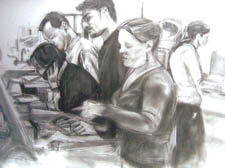|
|
 |
| |
 The Pharmacy Technicians II – Raaza Hussein (in the queue, second from right), 25, lives in Poplar: “I just saw it on the wall and it’s looking good. It shows us in the moment rather than in a pose. Before I started working here when I thought of a hospital I just imagined doctors and nurses. I didn’t realise the crucial jobs going on here including porters, caterers and technicians. That’s why this exhibition is so positive because you get to see not just faces you recognise but many aspects of hospital life.” The Pharmacy Technicians II – Raaza Hussein (in the queue, second from right), 25, lives in Poplar: “I just saw it on the wall and it’s looking good. It shows us in the moment rather than in a pose. Before I started working here when I thought of a hospital I just imagined doctors and nurses. I didn’t realise the crucial jobs going on here including porters, caterers and technicians. That’s why this exhibition is so positive because you get to see not just faces you recognise but many aspects of hospital life.” |
Camden Feature| Review of former nurse Frances Jayne Newman's Scene Unseen II exhibition at UCLH Gallery|
Former nurse Frances Jayne Newman has returned to the wards with an artistic eye
THE Scene Unseen exhibition showing at University College London Hospital is a nurse’s tribute to those who spend every working hour caring for others.
Frances Jayne Newman first became acquainted with the animated hospital corridors during a 12-year nursing career and, more recently, as artist in residence.
Frances, who lives in Homerton, Hackney, was more interested in the painstaking level of concentration porters, cleaners, pharmacists, canteen staff and carers bestow on their daily activities than in doctors frenetically saving lives, .
“I thought the hospital would be a bustling place, but when I sat back and looked at the drawings I found them really quiet and dignified,” she said.
“You think at first the cleaners are moving so slowly, but actually they are being really methodical.
“It’s only when you stop and watch them you notice. It’s almost like they’re drawing a line around everything.”
As a child, Frances, the daughter of a farmer, was always moving from one farm to the next and she was rarely without pencil and paper.
But it was not until she read the “inspiringly poetic words” of art critic John Berger when she was in her 30s that she decided to swap the scalpel for the pencil and study for a fine art degree at Middlesex University. A masters at Camberwell College of Arts followed.
“Observation and sensitivity were the tools of my trade when I was a nurse, and they still are now,” says Frances, who also runs art workshops at community centres and at the children’s ward of UCLH.
There is only one painting in the exhibition, depicting the curtain changer, whose work, she says, is like the legend of the painting of the Forth Bridge: once he reaches the top of the 16-floor building it’s time to start at the bottom again.
“We spend so much of our time working,” says Frances.
“And I’m completely fascinated by people, and in particular people who are overlooked – that’s why the subject of ‘labour’ is so interesting to me.”
These iconic images of people who are so often underestimated and undervalued are sensitively portrayed using graphite.
The more dynamic characters are drawn in lines of contour chalk.
Frances drew from blurred photos and quick sketches to get a sense of motion, and spent her weekends poring over the detail.
“We are just bombarded with images all the time” she says. “There’s something I find calming about black and white. It’s the same reason I did my MA in drawing – I wanted to go back to where everything begins.”
A catalogue with articles by author Ron Heisler and artists Eric Rimmington and Cecily Sash has been handed to all the models.
While there are representations of workers as living, breathing people in the etchings of artist Graham Sutherland, or in the sensitive drawings of Sylvia Pankhurst’s stooped factory workers, it’s worth noting, as Hielser does, how rarely workers are depicted – in socialist propaganda or otherwise – actually at work because of the tendency to show the worker as a symbol.
“Art is a commodity, so maybe it’s for that reason the people who can afford to buy art, the patrons of the art world, aren’t interested in people working,” says Frances. “Everything we do is political. But artists work on the outside of things and that gives you a freedom.”
It seems Newman caresses her images to life, as if she has experienced each job for herself. The result is a subtle and moving, unique historical document, which shines with admiration.
She said: “I want the subjects of my drawings to feel they are important enough to be worth drawing and maybe inspire them to think that maybe they could try and draw themselves.”
|
 |
|
 |
 |
|
 |
|



